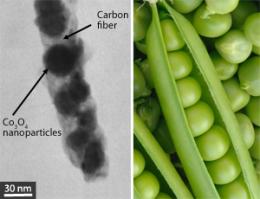Feb 11 2011
Lithium-ion batteries are used to power a wide range of electronic devices, including computers, cameras, digital audio players and calculators.
Tremendous effort has been devoted to the development of lithium-ion batteries, especially in improving the efficiency and integrity of the battery electrodes. This is because during the discharging and charging processes, lithium ions are repeatedly incorporated into and extracted from the electrodes by alloy formation or chemical conversion. These recurring events are known to cause the progressive degradation of the electrodes, irreversibly damaging battery performance.
 Cobalt oxide nanoparticles embedded in carbon fibers (left) to form peapod-like structures improve the lifetime of electrodes in lithium-ion batteries.
Cobalt oxide nanoparticles embedded in carbon fibers (left) to form peapod-like structures improve the lifetime of electrodes in lithium-ion batteries.
Yu Wang at the A*STAR Institute of Chemical and Engineering Sciences and co-workers have now demonstrated an elegant strategy to reduce the degradation problem and increase the capacity retention of lithium-ion batteries over many charge–discharge cycles. The strategy involves the use of a composite material with a peapod structure comprising cobalt oxide (Co3O4) nanoparticles embedded in carbon fibers (see image).
Cobalt oxide is a promising material for anodes in lithium-ion batteries because its capacity for holding ions is higher than that of conventional electrode materials, such as tin. In addition, Co3O4 can be easily converted to LiCoO2, which is the material currently used in commercial cathodes. The researchers made the peapod structures by heating cobalt carbonate hydroxide nanobelts coated with layers of polymerized glucose in an inert atmosphere at 700 ºC and then in air at 250 ºC. Electrodes built using the peapod composite had enhanced lithium storage and capacity retention—delivering 91% of the total possible capacity after 50 charge–discharge cycles.
“The Co3O4 nanoparticles act as active materials to store lithium ions and the hollow carbon fibers protect and prevent the Co3O4 nanoparticles from aggregating and collapsing,” says Wang. The carbon fibers also play the role of conducting electrons from the nanoparticles.
According to Wang, aside from the promising application in lithium-ion batteries, the fabrication of the peapod composite is an achievement in itself, as it is the first time that such isolated magnetic nanoparticles embedded in hollow fibers have been produced. Scanning electron microscopy revealed that the peapod composite exhibits a uniform morphology, with pod lengths of up to several micrometers and pod diameters of as small as 50 nanometers. The researchers believe that their method could be extended to generate encapsulated nanoparticles using a wide range of materials with applications beyond lithium-ion batteries, for example, in gene engineering, catalysis, gas sensing and the manufacture of capacitors and magnets.
Source: http://www.ices.a-star.edu.sg/